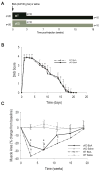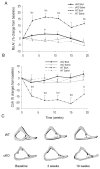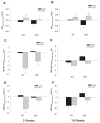Connexin43 deficiency reduces the sensitivity of cortical bone to the effects of muscle paralysis
- PMID: 21590735
- PMCID: PMC3306012
- DOI: 10.1002/jbmr.425
Connexin43 deficiency reduces the sensitivity of cortical bone to the effects of muscle paralysis
Abstract
We have shown previously that the effect of mechanical loading on bone depends in part on connexin43 (Cx43). To determine whether Cx43 is also involved in the effect of mechanical unloading, we have used botulinum toxin A (BtxA) to induce reversible muscle paralysis in mice with a conditional deletion of the Cx43 gene in osteoblasts and osteocytes (cKO). BtxA injection in hind limb muscles of wild-type (WT) mice resulted in significant muscle atrophy and rapid loss of trabecular bone. Bone loss reached a nadir of about 40% at 3 weeks after injection, followed by a slow recovery. A similar degree of trabecular bone loss was observed in cKO mice. By contrast, BtxA injection in WT mice significantly increased marrow area and endocortical osteoclast number and decreased cortical thickness and bone strength. These changes did not occur in cKO mice, whose marrow area is larger, osteoclast number higher, and cortical thickness and bone strength lower relative to WT mice in basal conditions. Changes in cortical structure occurring in WT mice had not recovered 19 weeks after BtxA injection despite correction of the early osteoclast activation and a modest increase in periosteal bone formation. Thus BtxA-induced muscle paralysis leads to rapid loss of trabecular bone and to changes in structural and biomechanical properties of cortical bone, neither of which are fully reversed after 19 weeks. Osteoblast/osteocyte Cx43 is involved in the adaptive responses to skeletal unloading selectively in the cortical bone via modulation of osteoclastogenesis on the endocortical surface.
Copyright © 2011 American Society for Bone and Mineral Research.
Conflict of interest statement
Roberto Civitelli has a Material Transfer Agreement with Zealand Pharma, Glostrup, Denmark, for the use of gap junction modifying peptides, but receives no honoraria or research funds from Zealand. He receives consultant fees from Novartis and Amgen, grant support from Eli-Lilly and Pfizer; and own stock of Eli-Lilly, Merck and Amgen. None of the other authors have financial conflicts of interest.
Figures





References
-
- Kjaer KW, Hansen L, Eiberg H, Leicht P, Opitz JM, Tommerup N. Novel Connexin 43 (GJA1) mutation causes oculo-dento-digital dysplasia with curly hair. Am J Med Genet. 2004;127A(2):152–157. - PubMed
-
- Flenniken AM, Osborne LR, Anderson N, Ciliberti N, Fleming C, Gittens JE, Gong XQ, Kelsey LB, Lounsbury C, Moreno L, Nieman BJ, Peterson K, Qu D, Roscoe W, Shao Q, Tong D, Veitch GI, Voronina I, Vukobradovic I, Wood GA, Zhu Y, Zirngibl RA, Aubin JE, Bai D, Bruneau BG, Grynpas M, Henderson JE, Henkelman RM, McKerlie C, Sled JG, Stanford WL, Laird DW, Kidder GM, Adamson SL, Rossant J. A Gja1 missense mutation in a mouse model of oculodentodigital dysplasia. Development. 2005;132(19):4375–4386. - PubMed
-
- Chung DJ, Castro CH, Watkins M, Stains JP, Chung MY, Szejnfeld VL, Willecke K, Theis M, Civitelli R. Low peak bone mass and attenuated anabolic response to parathyroid hormone in mice with an osteoblast-specific deletion of connexin43. J Cell Sci. 2006;119(Pt 20):4187–98. - PubMed
Publication types
MeSH terms
Substances
Grants and funding
LinkOut - more resources
Full Text Sources
Medical

